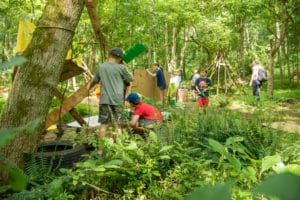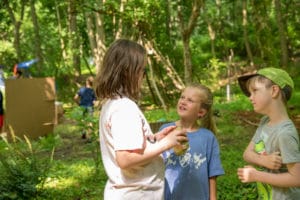The TimberNook program is designed to provide children the opportunity to explore nature, learn from the environment around them, and engage in creative play. As occupational therapists, we understand how much an individual’s environment can impact their overall growth. Occupational therapy views play as the most important element to a child’s development. As the American Occupational Therapy Association explains,
“It is often through play that children learn to make sense of the world around them. It is a child’s ‘job’ or ‘occupation’ to play to develop physical coordination, emotional maturity, social skills to interact with other children, and self-confidence to try new experiences and explore new environments.”
TimberNook provides the opportunity for children to develop all these areas while playing outside in nature. Throughout the summer, we have observed an increase in self-direction and development of new skills as children were challenged to engage in play with few directions and no adults providing suggestions about what they could play. The Storybook session with children ages 4-7 began with a morning song, get to know you game, rule review and reading a book before the kids were set loose to play with whatever and whomever they chose. As an adult, watching children navigate social situations, maneuver around obstacles in the woods, and create new games from their own imaginations was an amazing thing to witness. As the week progressed, younger children were asking for help from the older kids and working together to execute a plan or simply open a container.
Another valuable element to TimberNook is the focus on developing independence and problem-solving. In today’s world, children are so prone to seeking adult guidance as soon as something becomes challenging – not so with Timbernook. Children are given the time and space to think through how they could approach any given task and be successful. When they ask a TimberNook staff member a question, staff will often say “how do you think you could solve that problem?” before providing a suggestion. Children are also encouraged to develop the skill of “interoception” by acknowledging when their bodies need water and snacks to fuel themselves throughout the day. Once the kids realized they were able to go get their own snack and drink, asking for help from peers as needed, they began working in a snack break into their play to recharge for the rest of the day. It’s amazing what time and space can do to encourage children to learn and grow!


Kristen Beverly, MS, OTS
Molly Bartholomew, MS, OTS
Elizabethtown College

